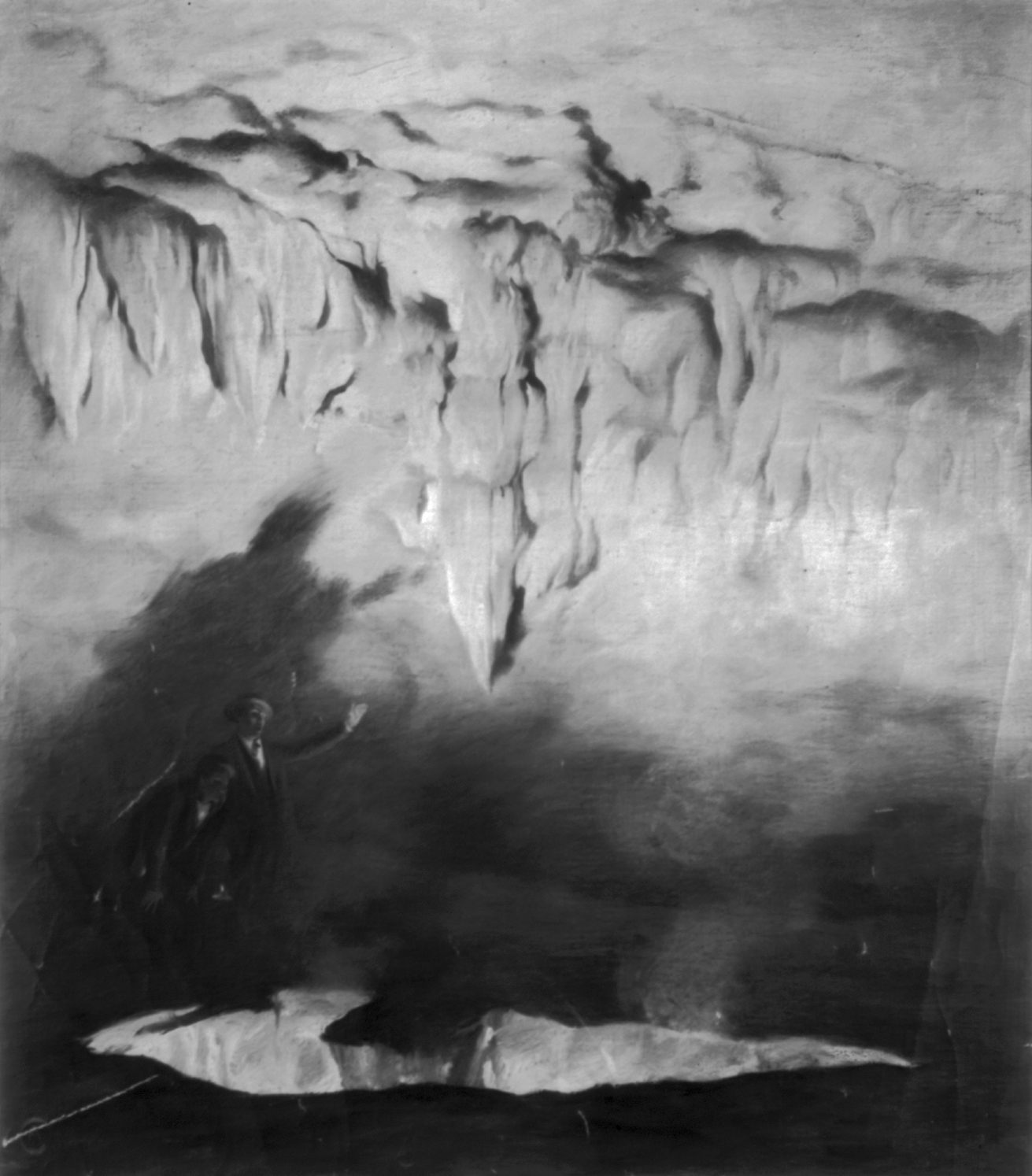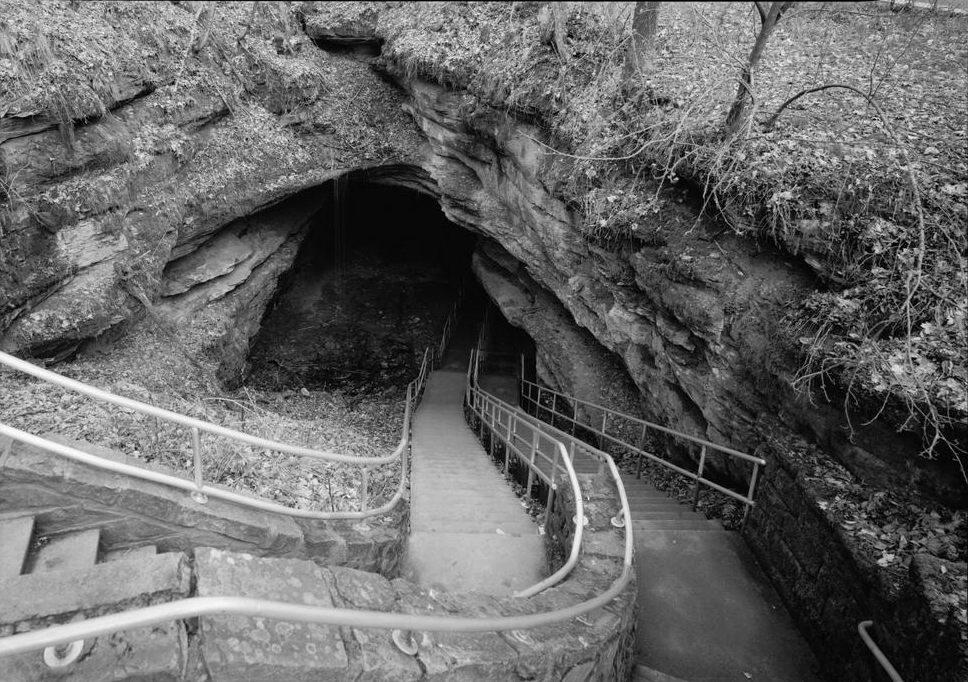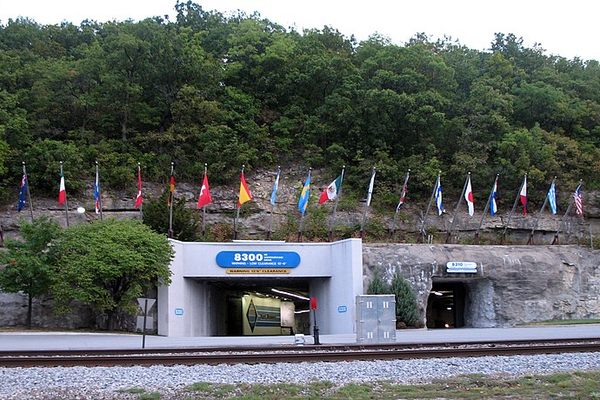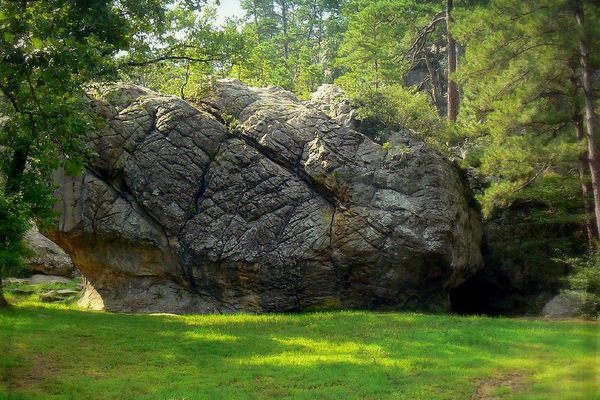The Nation’s First Tuberculosis Hospital Was Built Inside a Cave
Patients in Kentucky took their cures underground.

Consumptive’s Room, Mammoth Cave, Kentucky. (Photo: Library of Congress/LC-USZ62-64952)
A tourist visiting Mammoth Cave, just outside Bowling Green, Kentucky, in 1842 would have encountered “a bizarre scene. Pale, spectral figures in dressing-gowns moved weakly along the passageway, slipping in and out of shadowed huts, the silence of the cave broken by hollow coughing and muttered conversations.” They were consumptives, or tuberculosis patients, voluntarily living inside the cave as part of an early medical experiment. Although this experiment lasted just a few months, five patients died inside the cave and the rest passed away shortly after returning to the surface.
The patients lived in 10 wooden cottages constructed for them about a mile and a half inside the cave’s entrance. These minimal wooden cottages measured 12 x 18 feet, had tongue and groove floors, and simple canvas roofs. Two stone cottages completed the colony. One served as a community dining room and the other as a residence. Each cottage had a stove and thermometer so that patients could regulate the temperature of their homes. At the time, cool air was considered healthy, so patients were instructed to keep the temperature as low as they could bear. The experiment’s designer, Dr. John Croghan, said that the community had a “picturesque, yet at the same time, a gloomy and mournful appearance.”
The residents kept time and synced their schedule with the outside world. During the day, the cave was lit by stearin (fat) lamps and at night patients had their own taper candles. Once they got used to it, the darkness apparently did not bother patients. One mentioned that, “I seldom hear daylight mentioned and for myself seldom think of it.” Patients explored the cave, talked with each other, or read books to pass the time. Each Sunday, the small colony attended Episcopal services and read a sermon. Slaves brought meals into the cave and, according to one patient, these meals usually included venison.

Henry Duff Linton’s Harper’s Weekly engraving The Mammoth Cave - House Formerly Used by Consumptive Patients, 1877. (Photo: Library of Congress/LC-USZ62-119566)
Medical science had little to offer the 19th-century consumptive except fresh air, gentle exercise, and a good diet. Although cave air was not usually included in the regime, physicians of the era noticed that it sometimes preserved or improved health. The air inside Mammoth Cave, in particular, was reported to be especially potent. The cave remained at a steady 60 degrees Fahrenheit and, although a bit damp, proved to be “fine for the lungs, manifestly imparting strength.”
As evidence of these claims, the cave’s promoters pointed to the fact that none of the workers employed in the cave’s saltpeter mine became ill. In fact, according to an 1845 book, “it was a common and humane practice to employ labourers of enfeebled constitutions, who were soon restored to health and strength” because of their time spent working in the cave’s atmosphere. After the war, newspaper reports remarked with wonder that animal and human remains found in the cave remained “perfectly intact and undecayed.”
Convinced of the curative properties of the cave’s air, Dr. John Croghan purchased Kentucky’s Mammoth Cave, the longest cave system in the world, for $10,000 in 1839. He planned to build a large health resort at the cave. Three years later, in autumn 1842, he welcomed 11 patients, four of their companions, and the child of an invalid to the underground hospital.

Photographs outside Mammoth Cave. (Photo: Library of Congress/LC-USZ62-11004A)
Patients began Croghan’s experiment with optimism. In the 19th century, consumption was incurable and the patients who participated in the project felt that their dire condition justified dramatic action. One patient wrote in a letter that, “I felt stronger and took exercise freely, preserved a good appetite and seemed in the ascendant decidedly in the line of health.” He put the inconveniences of cave life in perspective by noting that, “we are pioneers under all the disadvantages of such and after generations will reap the benefit of our experiment…”
However, unsurprisingly life in the cave was difficult. The same optimistic patient also wrote that, “sometimes despite all my exertions to preserve cheerful feelings feel sad and desire above all things to return home again.” Patients struggled with the lack of light, isolation, and especially from the stagnant smoke from cooking and heating fires. One patient complained that it sometimes felt as though he lived in a “smoke house and was so seriously injured by it” that he planned to leave. Only a change in the weather and Croghan’s reassurance stopped him from returning to the surface. Only one patient, Oliver H.P. Anderson, departed the cave before the end of the experiment.

Croghan Hall, two men near maelstrom in Mammoth Cave, Kentucky by J. André J. Castaigne, 1898. (Photo: Library of Congress/LC-USZ62-93876)
The best description of the cave dwellers’ plight comes from Alfred, a slave and an experienced cave guide. He told the author of a travel guide that he would call the residents to dinner, “there were fifteen of them, and they looked more like a company of skeletons than anything else.” Another traveler wrote that, when the survivors “reached the light again, it was discovered that all their eyes were perfectly black, no matter what their original color had been.” This description probably exaggerated how much the invalids’ pupils dilated during their time in the cave.
Five patients died in the cave, their bodies laid out on Corpse Rock before returning to the surface. After the deaths began, Croghan ended the experiment and the survivors returned to the surface. These patients all died not long after leaving the cave. What happened to the child and otherwise healthy companions remains unclear. In the end, Croghan’s experiment lasted just a few months, from autumn 1842 through the early part of 1843.

A stereoscopic view of a group dining in the Great Relief of Mammoth Cave. (Photo: New York Public Library/Public Domain)
Dr. Croghan never published anything about the experiment’s disastrous outcomes and never reflected publically on his feelings about the men and women who died in his cave. Even with overwhelming evidence that cave dwelling did not prolong a consumptive’s life, he seemed hesitant to admit failure. In an 1843 letter, Croghan acknowledged that smoke collected in the cave, irritating his patients’ lungs, but believed this could be fixed by drilling a shaft from the surface down to the “invalid’s village.”
The Cave Cure failed, but physicians’ faith in pure air as a remedy for tuberculosis persisted long after Croghan’s patients shambled back to the surface. (This belief in the curative qualities of cool, clean air anticipated the work of Dr. Edward Trudeau and his staff at the Adirondack Cottage Sanitorium by 40 years.) After giving up on plan to turn the cave into a great health resort, Croghan dedicated his energies to building up the cave’s reputation as a general tourist destination, which it remains to this day.
Neither Croghan nor any other physicians tried to repeat the experiment and no other sick people took up residence inside the cave. Eventually, the wood frame huts were dismantled. The stone cottages were left standing but unoccupied. Dr. Croghan, like his patients, died of tuberculosis in 1849. Still, Americans in the 1860s and later continued to celebrate the cave’s atmosphere. In his 1882 guide book, Horace C. Hovey observed that, “The air is slightly exhilarating and sustains one in a ramble of five or ten hours, so that at its end he is hardly sensible of fatigue.”

Mammoth Cave entrance, late 1960s. (Photo: Library of Congress/HAER KY,31-MAMCA,1–1)
Stories about the cave-dwelling invalids remained popular among the cave’s visitors and in popular literature long after the disastrous experiment ended. In 1870, Dr. William Forwood explained that, “the idea of a company of lank, cadaverous invalids wandering about in the awful gloom and silence, broken only by their hollow coughs–doubly hollow and sepulchral there–is terrible.” Visitors to the cave often repeated chilling rumors about what happened to Croghan’s patients and sometimes reported hearing mysterious coughing in the area around the huts.
Even at the time, some physicians were amazed that Croghan tried the experiment. Although the cave’s cool, steady climate was considered appropriate for consumptives of the era, mid-19th century physicians believed that the “absence of light” made the disease worse and encouraged the “deposit of tubercles in the lungs.” Tuberculosis, called the “white plague,” was incurable until the discovery of streptomycin in 1943.
Today, visitors can still explore this “grand, gloomy and peculiar place.” The National Park Service, which has operated the site since 1941, offers tours of the cave and its surrounding areas. To view the stone tuberculosis huts, visitors will need to go on either the Violet City Lantern Tour or the Historic Tour of the cave. Although some people still claim that the cave air improves their health, the NPS does not recommend tours for anyone with serious health conditions.





















Follow us on Twitter to get the latest on the world's hidden wonders.
Like us on Facebook to get the latest on the world's hidden wonders.
Follow us on Twitter Like us on Facebook